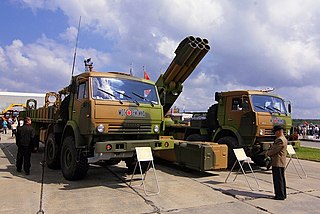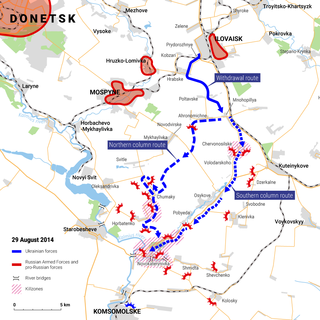
The 9A52-4 Tornado is Russia's newest universal multiple rocket launcher. It was designed as a lightweight and universal version of the BM-30 Smerch, dubbed 9A52-2. It was first unveiled in 2007 as a more strategically and tactically mobile launcher, albeit at the expense of a slight reduction in firepower. This model is aimed at replacing the previous generation of Russian multiple rocket launchers, including BM-21 Grad, BM-27 Uragan and BM-30 Smerch. Currently the sole operator is Russian Ground Forces. A version will be approved for export.

The war in the Donbas, or the Donbas war, is an armed conflict in the Donbas region of Ukraine, part of the broader Russo-Ukrainian War. From the beginning of March 2014, in the aftermath of the 2014 Ukrainian revolution and the Euromaidan movement, protests by Russia-backed anti-government separatist groups took place in the Donetsk and Luhansk oblasts of Ukraine, collectively called the Donbas region. These demonstrations, which followed the February–March 2014 annexation of Crimea by the Russian Federation, and which were part of a wider group of concurrent protests across southern and eastern Ukraine, escalated into an armed conflict between the separatist forces of the self-declared Donetsk and Luhansk People's Republics, and the Ukrainian government. While the initial protests were largely native expressions of discontent with the new Ukrainian government, Russia took advantage of them to launch a co-ordinated political and military campaign against Ukraine. Russian citizens led the separatist movement in Donetsk from April until August 2014, and were supported by volunteers and materiel from Russia. As the conflict escalated in May 2014, Russia employed a "hybrid approach", deploying a combination of disinformation tactics, irregular fighters, regular Russian troops, and conventional military support to destabilise the Donbas region.

During the rising unrest in Ukraine in the aftermath of the 2014 Ukrainian revolution, the city of Mariupol, in Donetsk Oblast, saw skirmishes break out between Ukrainian government forces, local police, and separatist militants affiliated with the Donetsk People's Republic. Government forces withdrew from Mariupol on 9 May 2014 after heavy fighting left the city's police headquarters gutted by fire. These forces maintained checkpoints outside the city. Intervention by Metinvest steelworkers on 15 May 2014 led to the removal of barricades from the city centre, and the resumption of patrols by local police. Separatists continued to operate a headquarters in another part of the city until their positions were overrun in a government offensive on 13 June 2014.

The 2nd Battalion of Special Assignment "Donbas" is a unit of the National Guard of Ukraine subordinated to the Ministry of Internal Affairs of Ukraine and based in Severodonetsk. Originally created in 2014 as a volunteer unit called the Donbas Battalion by Semen Semenchenko following the Russian occupation of Crimea and possible invasion of continental Ukraine. The formation of the unit started in the spring of 2014 during the 2014 pro-Russian unrest in Ukraine. The unit was initially formed as an independent force, but has been since fully integrated into the National Guard as the 2nd Special Purpose Battalion "Donbas" within the 15th Regiment of the National Guard.

On 13 July 2014, mortar shells fired from Ukrainian territory landed in the courtyard of a private home in the border town of Donetsk in the Rostov Oblast of Russia, according to Russian officials. The shelling killed one civilian and injured two others.

The Battle in Shakhtarsk Raion began on 16 July 2014, when the Armed Forces of Ukraine attempted to cut off insurgent supply lines from Russia. Fighting broke out around the towns of Marynivka, Dmytrivka, Stepanivka, Shakhtarsk, as well as the strategic hill of Savur-Mohyla. It later spread to the cities of Snizhne and Torez. While the battle was in progress, a civilian passenger airliner, Malaysia Airlines Flight 17, was shot down near Hrabove. Amidst a wide counter-offensive by the insurgents and their Russian backers across Donbas, government troops were forced out of Shakhtarsk Raion on 26 August.

The Battle of Ilovaisk started on 7 August 2014, when the Armed Forces of Ukraine and pro-Ukrainian paramilitaries began a series of attempts to capture the city of Ilovaisk from pro-Russian insurgents affiliated with the self-proclaimed Donetsk People's Republic (DPR) and detachments of the Russian Armed Forces. Although Ukrainian forces were able to enter the city on 18 August, they were encircled between 24 and 26 August by overwhelming Russian military forces that crossed the border, joining the battle. After days of encirclement, government forces allegedly made an agreement with the insurgents to be allowed to retreat from the city. This agreement was not honoured, and many soldiers died whilst trying to escape.

Fighting between Donetsk People's Republic separatist forces affiliated with Russia, and Ukrainian military and volunteer forces broke out at Donetsk International Airport on 28 September 2014, sparking the Second Battle of Donetsk Airport, a part of the ongoing war in the Donbas region of Ukraine. This followed an earlier battle over control of the airport in May 2014, which left it in Ukrainian hands. The new battle was sparked despite a ceasefire agreement, the Minsk Protocol, that had been in place from 5 September. At the start of the battle, the airport was the last part of Donetsk city held by government forces, and it lies between the separatist and Ukrainian lines of control. Heavy fighting over the airport continued into the new year, with some of the worst fighting having taken place in January 2015. On 21 January, separatist forces overran the government's positions at the airport. The remaining Ukrainian forces were either killed, forced to retreat, or captured.

An attack on Mariupol was launched on 24 January 2015 by pro-Russian forces associated with the Donetsk People's Republic against the strategic maritime city of Mariupol, defended by Ukrainian government forces. Mariupol had come under attack multiple times in the past year in the course of the War in Donbass, including in May–June 2014, when the city was under the control of pro-Russian forces; and the September 2014 offensive.
Dovzhansky is a land border crossing between Ukraine and Russia on the Ukrainian side, in the town of Dovzhansky, Sverdlovsk city municipality, Luhansk Oblast.

40th Motorized Infantry Battalion is a formation of the Ukrainian Ground Forces. It was originally formed as the 40th Territorial Defence Battalion "Kryvbas" in Kryvyi Rih.
The Russian cross-border artillery shelling of Ukraine happened in July–September 2014 amidst the war in Donbas to prevent the defeat of the self-declared Donetsk and Luhansk People's Republics. The Russian Armed Forces performed a series of artillery strikes targeting Ukrainian troops in the Donbas region of Ukraine.

This is a timeline of the war in Donbas for the year 2014.

This is a timeline of the war in Donbas for the year 2015.

This is a timeline of the war in Donbas for the year 2016.

This is a timeline of the war in Donbas for the year 2020.

This is a timeline of the war in Donbas, from 1 January 2017. The timeline follows an ongoing conflict between Ukraine and anti-government pro-Russian separatists supported by Russian troops in the Donbas region in eastern Ukraine.

This is a timeline of the war in Donbas for the year 2021.
Fights on the Ukrainian–Russian border in 2014, also famous as "Operation to restore the state border", "Battle at the border", Battle in sector D , – an episode of the war in eastern Ukraine, the battle of anti-terrorist operation forces against illegal armed groups supported by Russian artillery in the border areas of Donetsk and Luhansk regions during summer campaign in Donbass. Fighting broke out in Sector D of the anti-terrorist operation during the "operation to restore the state border" during June–August 2014. The main task of the Anti-Terrorist Operation Forces was to restore control over the section of the state border Izvaryne – Kumachovo and to cut the routes for illegal armed groups.









